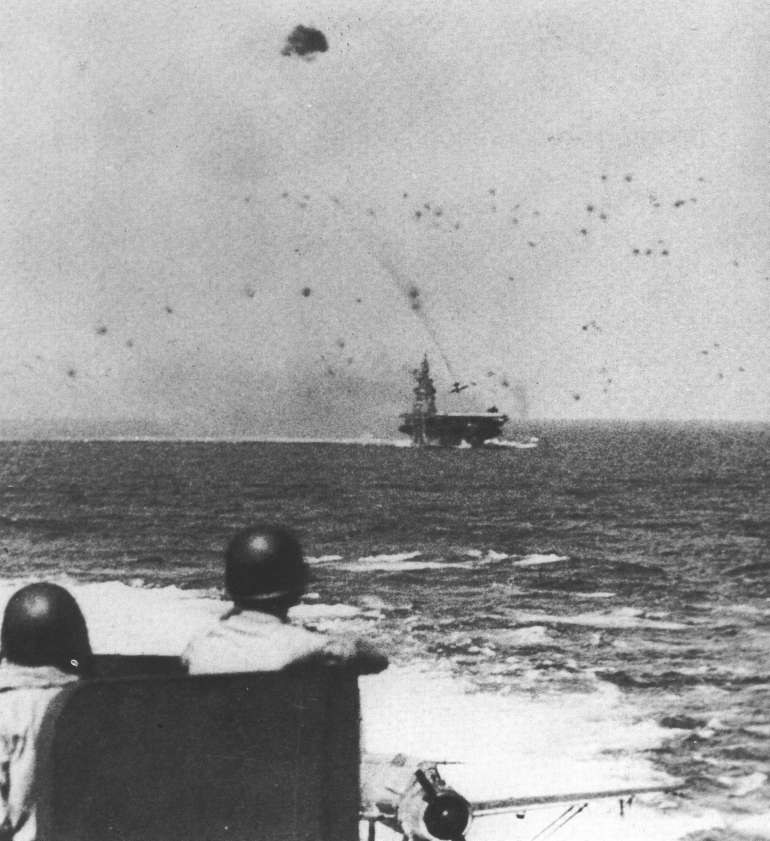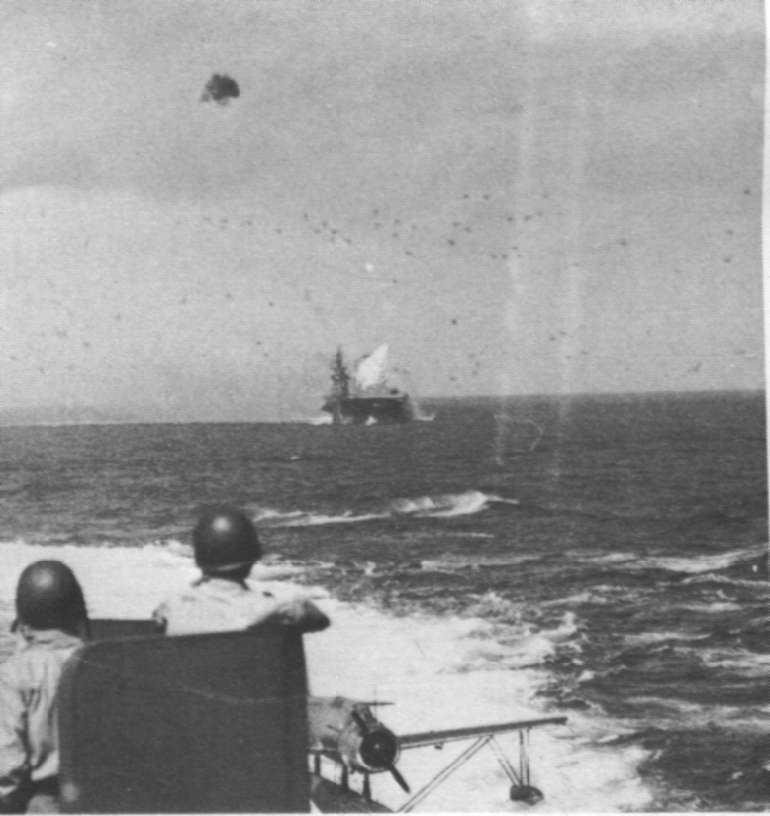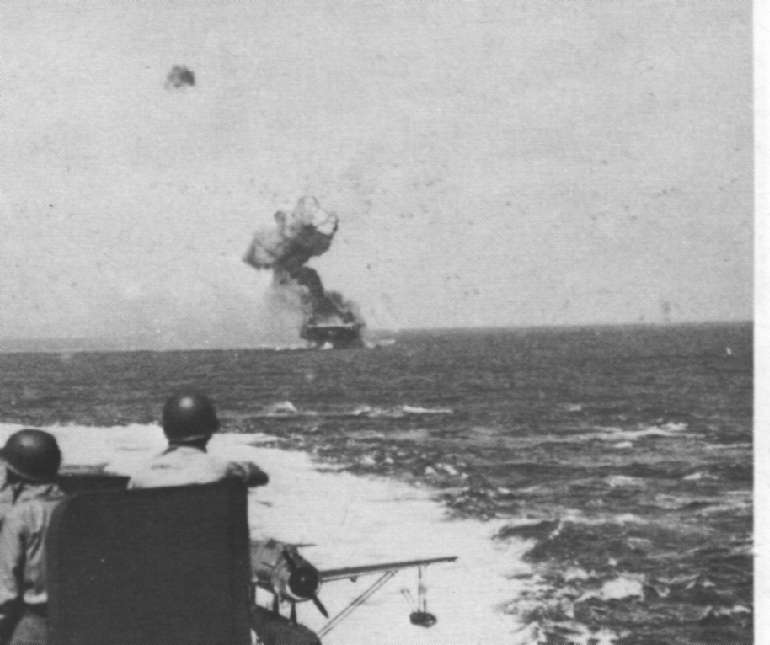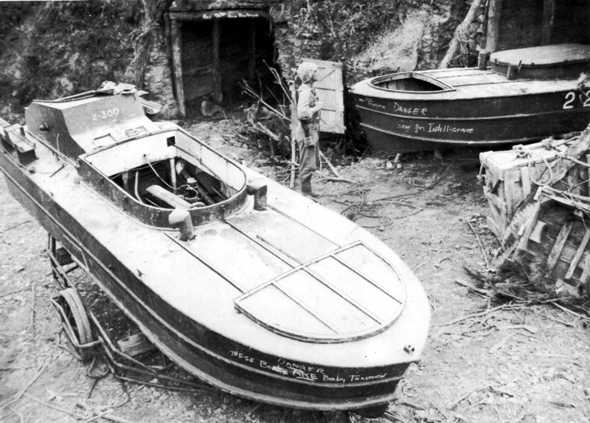|
Posted on 05/23/2003 5:37:11 AM PDT by SAMWolf
|
|
 are acknowledged, affirmed and commemorated.
|

| Our Mission: The FReeper Foxhole is dedicated to Veterans of our Nation's military forces and to others who are affected in their relationships with Veterans. We hope to provide an ongoing source of information about issues and problems that are specific to Veterans and resources that are available to Veterans and their families. In the FReeper Foxhole, Veterans or their family members should feel free to address their specific circumstances or whatever issues concern them in an atmosphere of peace, understanding, brotherhood and support.
|
|
|
|
Japanese Kamikazes In the 13th century, as legend goes, a Mongol emperor massed a large fleet for the invasion of Japan. The Japanese nation had little to defend itself with, and a Mongol conquest seemed certain. As the fleet massed outside Tokyo Bay gathered to attack, a typhoon came up and either sank all the ships or blew them back to China. This storm, which the Japanese believed was sent by the gods to save their nation, was called "Divine Wind." In Japanese, the name is "Kamikaze."  Vice Admiral Takajiro Ohnishi, Japanþs foremost expert on naval aviation and at one time Admiral Isoroko Yamamotoþs close advisor on the subject, formulated a plan wherein Japanese pilots would suicide-crash their planes into American ships. This tactic, which Ohnishi hoped would save Japan, was called kamikaze, in honor of the typhoon that saved his country from invasion. The formal name of the unit that had this mission was the Kamikaze Special Attack Corps. The kamikazes were unique in military history. Death in war is inevitable, but Japanese naval doctrine prior to 1944 forbid carrying out a mission unless there was some chance of survival. Adhering to the code of bushido (code of the warrior), all Japanese military men were prepared to die for the Emperor. This stemmed from the Japanese ideal of "The Path of Eternal Duty," the belief that family and individual welfare were not important when compared to the long history of the Empire. Japanese literature is replete with examples of warriors who died a glorious death on behalf of the Emperor. The kamikazes, however, were the first unit to actually seek death in battle. This concept was repugnant in the West, and there were those on the Japanese Imperial General Staff who objected to this strategy. They felt this step was needless, a waste of men, and an acknowledgement that Japan had lost the war. In spite of this opposition, Ohnishi lobbied strongly for his plan, and it was finally, if reluctantly, accepted.  The American invasion of Leyte (the Philippines) in October 1944 saw the debut of the kamikazes. The escort carriers guarding the transports and beaches had the dubious honor of being the first American naval units to encounter the Divine Wind. "Sacred warriors" sank the escort carrier St. Lo and damaged several other ships. Their efforts had little effect on the invasionþs outcome. The damage they inflicted, however, was a prelude to later and more effective massed attacks, particularly at Okinawa. The kamikazes continued attacks against American shipping through the remainder of the campaign in the Philippines. During the invasion of Iwo Jima, they continued the strategy of attacking shipping, both combatant and transport. Some escort carriers were sunk and some major fleet combatants, particularly the aircraft carrier Franklin, were severely damaged. However, Iwo Jima was taken and secured. The significant point about these two campaigns was that these kamikaze attacks were carried out independently of other Japanese defense measures. Okinawa was different.  At Okinawa, which was invaded by American troops on Easter Sunday, 1945, the kamikazes were incorporated from the beginning as an integral part of the defense of the island. Being the closest land to the Empire yet invaded, Japanese strategists were determined to hold the island at all costs. Kamikaze operations at Okinawa were the fiercest of the war, and the most frightening, in view of their intensity. The Okinawa kamikazes were called "kikusui," meaning "floating chrysanthemum," in honor of the imperial symbol of Japan. From the onset of the invasion until the end of the Okinawa campaign, over 1,900 suicide attacks took place. The largest number of attacks was carried out during the period April 6-7, when 355 planes participated. American strategy was revised to deal with the threat. An outer picket ring of radar-equipped ships, usually destroyers, destroyer escorts and minesweepers, was established to provide early warning of incoming kamikaze raids. It was hoped that with enough advance warning, fleet units would be able to disperse in time to repel the threat. These picket ships bore the greatest brunt of the kamikaze attacks. They were often kamikaze targets because from the air, the inexperienced Japanese flyers mistook them for battleships and cruisers.  One of these picket ships underwent an amazing ordeal in the waters off Okinawa on April 16, 1945. The destroyer Laffey, under the command of Commander (later Rear Admiral) F. Julian Becton, was assigned to radar picket station No. 1 that day. In a period of 80 minutes, Laffey underwent 22 separate attacks by 32 planes. She was struck by six of them, suffered four bomb hits and was continuously strafed. Her gunners destroyed at least eight of the attackers. At the conclusion of the attack, only four of Laffeyþs 20mm mounts were still firing. Her main batteries were destroyed, her stern was almost awash, her rudder was jammed, and she was barely able to make steam. Laffeyþs gallant crew, under the direction of Becton, who vowed that he would never abandon his ship while one of its guns still fired, made heroic efforts to save their stricken vessel. They not only kept Laffey afloat, but managed to bring her home to Seattle, Washington, under her own power for repairs. Laffey continued in service until well after World War II, when she was finally and honorably decommissioned. Were the kamikazes successful? From a strategic and tactical point of view, the answer is "no." Ohnishi hoped they would turn the tide of the war in Japanþs favor, and allow at least a negotiated peace. He had hoped that the Americans would psychologically be unable to deal with this type of threat. He was wrong on both counts.  The kamikazes operating during the Okinawa campaign did take a terrible toll on American lives and ships. At the beginning of the suicide operations, there was stunned disbelief on the part of American sailors that other men would be willing to kill themselves in order to destroy them. Because the threat was continuous, shipsþ personnel were forced to remain at battle stations for days on end. Fatigue began to take its toll, on ships and men. Sleep and food, often taken for granted, became precious to American sailors. In summation, the Okinawa kikusui operation damaged 368 ships and sunk 32. Suicide planes killed 4,900 American sailors and wounded over 4,800. These were the heaviest losses incurred in any naval campaign in World War II. Over 2,000 Japanese pilots lost their lives in the suicide attacks off Okinawa. Because the many kamikaze attacks at Okinawa did not stem the American advance, Vice Admiral Matome Ugaki, commander of the Japanese 5th Air Fleet, wanted to atone to the Emperor and the kamikazes who died under his command. He ordered three planes readied, intending to lead a final suicide attack against Okinawa. The attack was scheduled to leave Japanþs Kyushu Island on Aug. 15, 1945, the day the Emperor announced the decision to surrender.  When Ugaki went to his plane, 10 others were revved up on the runway with it. Questioning this, Ugaki was told by the squadron leader that when the fleet commander himself led the attack, every squadron plane would follow. True to the code of the warrior, the 11 took off for Okinawa. Symbolic of the futility of the kamikaze attacks in changing the warþs outcome, the mission did not succeed. The plane flown by Ugaki fell harmlessly into the Pacific Ocean. Late in the evening of Aug. 15, Ohnishi, the man who sowed the Divine Wind, committed hara kiri, the ritual suicide of the Japanese warrior.
|

SUICIDE BOATS" wrecked by their crews were found by the 77th Division as it mopped up in the Keramas. They looked like small speedboats but were poorly constructed and quite slow, These two craft (below) were captured in their cave shelters by American troops on Okinawa. Note booby trap warnings and crude depth charge racks at stern.
By Dwight Daniels

The aircraft carrier Randolph was tended by an unidentified support ship as it underwent repairs in March 1945 to mend the massive hole in its aft flight deck.
Robert Miller felt as safe March 11, 1945, in the central Pacific as he would have if his warship were anchored in San Diego Bay.
Miller, a young supply officer aboard the destroyer escort Lewis, and his fellow crew members were enjoying a rare luxury – a movie.
Suddenly, a massive explosion erupted on a ship moored next to theirs in the western Caroline Islands. The aircraft carrier Randolph was in flames.
"The sky forward of us was lit up like the finale of a Fourth of July fireworks display," said Miller, who was 22 at the time.
He didn't know it then, but he had just witnessed the aftermath of a kamikaze attack.
The pilot of a Japanese twin-engine bomber had smashed his plane into the Randolph's aft flight deck, killing more than two dozen crewmen and injuring many more.
On Veterans Day 2002, with talk of war and reports of suicide attacks back in the news, people like Miller can't help but remember the long-ago sacrifices of their brothers in arms.
In the chaos that day 57 years ago, Miller and others manned their battle stations in case there was an attack on their own ship while the Randolph's sailors fought flames that threatened to consume the carrier.
A second attack never materialized, but rumors swirled around the Lewis' decks for days as to what had caused the explosion aboard the bigger ship, Miller said.
"It was not like today. We were never told for sure," said Miller, 80. "I had to be satisfied with the scuttlebutt."
More than 50 years later, Miller finally resolved the nagging question. He arrived at the truth in the oddest fashion – while reading an obituary in July 1998 in The San Diego Union-Tribune.
In an article tracing the life of Jesse C. Madden, an 88-year-old retired Navy lieutenant commander who served as a flight-deck officer aboard the Randolph on that day in 1945, Miller learned the carrier had suffered a kamikaze attack.
"Twenty-five men were killed and 106 wounded in the attack, which damaged the starboard side of the carrier just below the flight deck," Miller recalled reading in the article.
But at the time of the incident, Miller had little time to worry about the statistics of war casualties. His ship was soon to be heading out of its Ulithi Atoll anchorage on combat patrols and anti-submarine warfare duty, and to support the invasion of Okinawa.
Confined to their ship, the Lewis' crew members focused on the small pleasures of life, such as letters from home and movies, to block out the death and destruction.
Ironically, the film Miller believes he and others were watching the night of the kamikaze attack was "For Whom the Bell Tolls," a war movie based on the Ernest Hemingway novel.
It was obtained from another Navy ship through a trade of 300 pounds of frozen boneless beef – including Grade A filet mignon – from the ship's rations.
Miller, in charge of logistics, was behind the acquisition. "With Ingrid Bergman and Gary Cooper, (this) was the most sought-after flick in existence," he said.
His captain had insisted on the deal.
"He'd told me, 'Get that movie at all costs,' " Miller said.
The lieutenant junior grade ordered signalmen to transmit "blinker" messages spelling out terms of a deal to a potential trading partner. The signals were relayed from ship to ship because the vessel with the film was out of direct blinker range.
That ship wanted the quality beef in exchange for Bergman and Cooper.
Miller and a three-man crew took a 17-mile journey on the Lewis' whaleboat to pick up the reels. Miller later traded the movie to a third ship for 300 gallons of "real" ice cream – another wartime luxury.
"This movie has stuck in my memory for more than 50 years, not so much for the entertainment value . . . but for the ordeal and hazards in getting it," Miller said.
As the war continued, Miller drifted further away from the attack on the Randolph.
"There were so many other exciting things going on," he said.
When the atomic bombs were dropped on Japan and the war in the Pacific ended, Miller left the Navy, attended law school and built a successful practice in civil litigation in Tucson.
He married and had four sons, but lost his wife and two boys in a plane crash during a vacation trip to Mexico in 1966.
Miller bought a second home in La Jolla in 1968 – it was a favorite family spot – and has lived there about half of his time since he retired in 1982. His two surviving sons are attorneys in Arizona.
Miller supposes that if he had tried, he could have looked up Navy historical accounts of what happened the night the kamikaze hit the Randolph.
Had he known Sal Rizza, Miller could have received a firsthand account.
Rizza, 77, a retired insurance executive, confirmed from his Florida home that it was a kamikaze attack that nearly destroyed his ship. He was a 19-year-old seaman then, assigned below the Randolph's flight deck to tie down planes.
A member of the Randolph Association, a confederation of sailors who served aboard the carrier over the years, Rizza said he was playing cards below decks when he "felt a huge thump."
"I said, 'Holy cow, what was that?' " Rizza said. "There was chaos, people running everywhere, with smoke and hoses.
"I went down and got my (gas) mask. You could smell the fumes through the ventilation system. When I got up (on deck), sailors were trying everything they could to help out."
The victims had all been on what is known as the fantail, a designated smoking area at the stern. Two of Rizza's friends were killed.
"They did the same job I did," he said. "We worked together. I often wonder, there but for the grace of God go I.
"It's just fate."
The blast was so horrific that recovery crews were still pulling out bodies three days after the attack, according to a diary kept by one of the Randolph's shipboard physicians.
"Find a few more bodies in the debris," an entry from March 14 states. "Several of our (injured) men die on board the USS Relief (a hospital ship)."
The carrier stayed at Ulithi until early April for repairs, and rejoined the fleet for the Battle of Okinawa.
Miller said reading about the Randolph's fate in Madden's obituary rekindled fond memories of a trying but eventful time.
"I'm just fortunate I came out (of the war) not having been wounded or injured," he said. "And my time in the Navy was some of the happiest, (most) fulfilling days of my life."

Burning aft after she was hit by a Kamikaze, while operating off the Philippines on 30 October 1944. Flight deck crewmen are moving undamaged TBM torpedo planes away from the flames as others fight the fires. USS Franklin (CV-13), also hit during this Kamikaze attack, is afire in the distance.


Afire and listing after she was hit by a Japanese air attack while operating off the coast of Japan, 19 March 1945. Photographed from USS Santa Fe (CL-60), which was alongside assisting with firefighting and rescue work

Ship's after 5"/38 twin gun mount burning, as her crew tried to control fires on 19 March 1945. The carrier had been hit by a Japanese air attack while operating off the coast of Japan. Photographed from USS Santa Fe (CL-60), which extinguished the fire in this gun mount by playing streams of water through the mount's open door. Later, the other 5"/38 twin gun mount and the 40mm quad machine gun mount (at right) also burned. Note ammunition loaded in the feed racks of the 40mm guns.

View on the flight deck, looking forward, while the carrier was in New York Harbor, circa 28 April 1945. She had just returned from the Pacific for repair of battle damage received off Japan on 19 March 1945. Note damage to her flight deck, large U.S. ensign flying from her island, and the Manhattan skyline in the background.

Church service on the ship's ruined hangar deck, taken upon her return to the U.S. from the Pacific for repair of battle damage received off Japan on 19 March 1945. Location is probably in, or near, New York Harbor, circa 28 April 1945.

The road to nowhere or off the deep end?
LOL.



What????
SAMWolf!!! Shame on you!!
Disclaimer: Opinions posted on Free Republic are those of the individual posters and do not necessarily represent the opinion of Free Republic or its management. All materials posted herein are protected by copyright law and the exemption for fair use of copyrighted works.